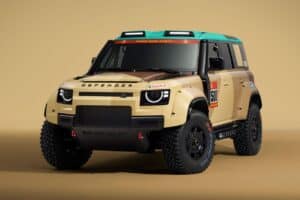Cruise to the office on electric range and hit the open road with a petrol engine.

It’s been quite a ride since the Land Rover Defender made its highly-anticipated debut in 2020.
After initially rolled out in 110 guise, 90 and 130 models were introduced to the range. In similar vein, a variety of powertrains joined the South Africa line-up over time.
The latest one of these is the plug-in hybrid called the P400e and offered locally only in two 110 derivatives. The Citizen Motoring recently sampled one of them, the Land Rover Defender 110 P400e X-Dynamic HSE.
ALSO READ: Know the PHEVs from the BEVs in Volvo’s new energy repertoire
Land Rover Defender packs a punch
This Defender P400e comes with a combination of a 2.0-litre, four-cylinder turbocharged petrol engine and electric motor. The mill produces 221 kW of power and combines with the 105 kW electric motor to deliver a total of 297 kW and 640 Nm of torque. This is sent to all four wheel eight-speed automatic transmission.
Land Rover claims the 2 545 kg will sprint from 0 to 100 km/h in 5.6 seconds. The Citizen Motoring did not put this to the test, but we’ll take their word for it. As well as for the claimed top speed of 209 km/h on the 22-inch wheels our test unit rode on.

A 19.2 kWh battery gives the Land Rover Defender P400e a claimed electric range of 59 km. Although this number might not look significant on paper, it is the whole purpose of the model’s existence.
As we drove the Defender P400e straight off the showroom floor, the actual range was almost 40% less than the claimed one as the battery was not at its optimal potential yet, which it should be after several charge cycles.
ALSO READ: Junior Land Rover Defender on course for 2027 reveal
Home wall box key
What we also learnt was visits to fast chargers and reliance on standard three-point plug chargers defeats the purpose of this plug-in hybrid.
One trip to a 22 kW charger at a Land Rover dealership turned out into quite a disappointment as it needed close to two hours for the depleted battery to fully charge. Time we did not have.
The other problem with fast chargers being that unless they are on your way and you have time to kill there, you are going to be driving – and wasting your time waiting there – for a range that will already be depleted when you are back on your normal daily route.
ALSO READ: Rugged Outbound and V8 Land Rover Defender 130 models confirmed
Charging the Land Rover Defender P400e from a standard wall plug at home proved more successful. Even with several bouts of load shedding overnight, we managed to get the battery level to 88%.

But the moral of the story is, when you own this car, you will only use the above two ways of charging in emergencies. But you get a faster wall charger installed at your house as part of the deal. Which means you should be able to achieve a full charge overnight regardless of load shedding.
ALSO READ: Land Rover Defender V8 has the bite to match its bark
Save at the pumps
Armed with an electric range of 59 km, you should be sorted for everyday life. As many office buildings are starting to install chargers in their parking lots these days, you might even be able to top up your electric range while at work.
And in the event of your battery running flat, there is no need to stress too as you have a perfectly fine internal combustion engine to fall onto with the added benefit of a 90-litre fuel tank. This is what you are going to use anyway for longer trips or when going on holiday.
But the beauty of R2 135 900 the Land Rover Defender 110 P400e is it offers the best of both worlds. Everyday trips done on electric range will cost you around a fifth of the price of fuel, while you can fall back on good old petrol power any time you want to … or need to … like in the bush.
But as we struggled to achieve fuel consumption better than 14 L/100 km travelling with a depleted battery, you’d probably want to keep the battery charged.






